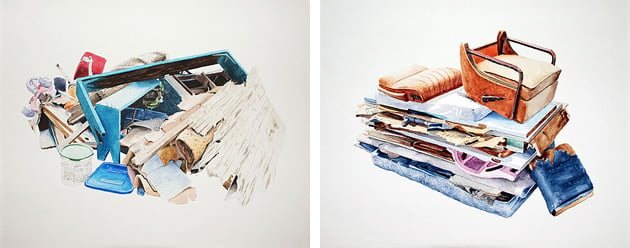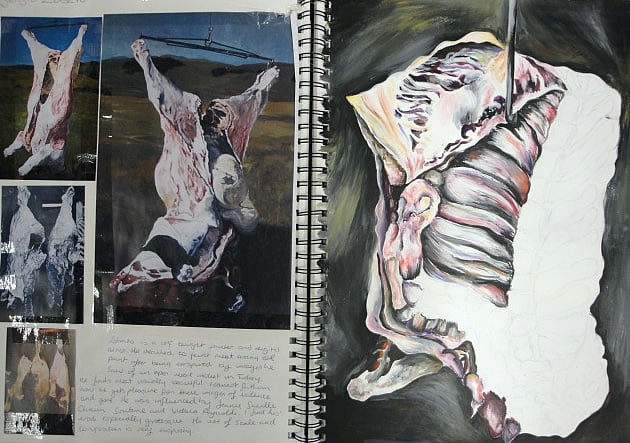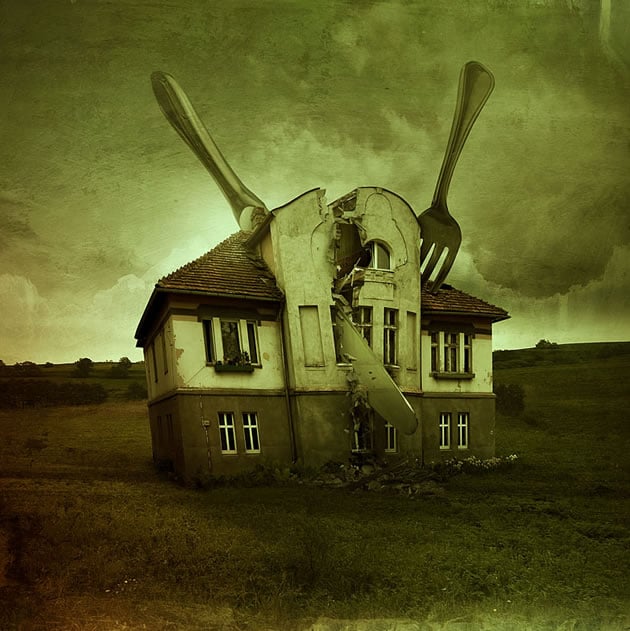GCSE / IGCSE / A Level Art Exam Ideas 2013
Concluding Updated on February 8, 2017
This article aims to help GCSE, IGCSE and A Level students come up up with ideas, interpretations and artist models for their 2013 Art Exam papers. Responses are given to topics from a number of unlike exam papers from examination boards such as AQA, Edexcel and CIE. These suggestions are not intended to be a complete list, nor to provide 'perfect' ideas: rather they have been supplied to help you with the brainstorming process. Final selection of ideas should just exist made in conjunction with advice from your instructor.

Equally noted in the 2012 Art Examination topics commodity:
No topic is inherently boring. Even the near mundane tin result in beautiful work. What matters is not the thing or fifty-fifty the idea, but the fashion it is interpreted; the way you respond to information technology, what information technology means to you and whether it wriggles inside and kicks at your soul.
It is important to remember, too, that it is not always necessary to have an exceptionally clever or original interpretation. Sometimes a literal or uncomplicated approach can be conveyed in a imaginative, practiced and unique style. If you lot accept spent days searching for the 'perfect' interpretation, consider whether this time would be better spent starting and creating artwork. Skilful artwork takes fourth dimension. Terminate fretting nearly whether your idea is perfect and brainstorm.
Force (GCSE Fine art and Design Edexcel)
- Animal forcefulness / violence (relating to a particular circumstance, scene or activity)
- Athletics / homo strength / physical activity (focused on one particular activity or sport)
- Move involved in a particular forceful action
Paintings depicting motility by Simon Birch and David Agenjo:

- Peer force per unit area (relating to a particular behaviour / activity / activity)
- Trees / landscapes ravaged by wind
- Rain lashing a particular scene
- A boiling hot summertime'due south mean solar day / icecream melting
- Decay / rot / mould: an outdoor construction succumbing to the forces of nature
- Backwash of an convulsion or another natural disaster
- Floods / slips / erosion / cars swept away in swirling flood waters
- Bombs / terrorist activeness
- Gravity / falling / precarious sculptures / structures
An imaginative painting exploring gravity by Jeremy Geddes:

- Scientific analysis of forces (sometime textbooks / diagrams / scales)
- Friction
- The conversion of one forcefulness to some other: i.e. an quondam mechanical plow / pulleys / cogs
Beautiful works from a serial entitled 'Man and the Motorcar' by Kelani Abass:

- The force of waves disintegrating items at the edge of the bounding main
- Electric forcefulness fields
- Political / religious forces
- Societal obligations to suit
- Human perseverance in a trying circumstance / willpower / desire to survive / force of life
- Breaking or smashing something
- Car crashes
Clever collaged artwork by Patrick Bremer:

- Recycled items being crushed together prior to transporting
- A building being demolished
- A notwithstanding life where items are balanced precariously / crushed from above / squashed
- A wreckers k
Striking scenes by Jason Webb:

- A nut cracker
- Breaking something obscure and unexpected into tiny pieces and reassembling these, or using as the basis for a still life
Case of an abstract sculptural form created by Cornelia Parker:

- The human being trunk subjected to forces of some kind: pushing / pulling / shredding
- Mental forces and the way these shape or deform our existence
Intriguing artwork past Henrietta Harris:

Art2day has also put together a collection of images that might inspire here. For more artist model ideas, please visit the Student Art Guide Pinterest Boards.
Juxtoposition (IGCSE Art and Design CIE)
- Siblings sitting side past side
- Unexpected items sitting adjacent on a refrigerator shelf, or in a pantry, or supermarket shelves
- Different species of animals living happily in close quarters
- Wild animals alongside tame / domestic
- Unexpected combinations of objects at unexpected scales
Surrealist paintings past Matthew Grabelsky:

- Good for you food alongside unhealthy food
- Multiple views of a single person within one portrait
- Unexpected items in bowls of food
- Drawings of items alongside actual items (integration of drawing with photography: drawings of drawings)
Beautiful print by Aaron Horkey:

Open (IGCSE Art and Blueprint Edexcel)
- Architectural openings – looking through windows / doorways / framing of scenes
- Bodily openings (wounds / scars)
- Open mouths: the never ending want to be fed
Case: Scotch Record Series past Naman Photography:

- Pile of open books / letters / desk scene
- Animals in cages / open latches / gates / escape
- Birthday scene – unwrapping / opening presents
- Unexpected packages containing random items
- The peeling open up of nuts / fruit / vegetables / discarded skins
- Brute carcasses
A peachy Foundation sketchbook page depicting open up hanging carcasses by Seamus O'Dare:

- Gutting fish
- Open up pair of scissors / surgical instruments
- Open hands / fingers / holding of precious items
- Breaking open up something unexpected
Instance by Dennis Sibeijn:

- Open boxes / cartons / packaging
- Grocery numberless spilling open
- Flies landing on a food particular that was left open
- Opening seedpods
Beautiful drawings by students of Monica Aissa Martinez:

Floating (AS Art and Pattern OCR)
- Pond / diving
- Ducks and ducklings
- Something horrific floating in water
- Rubbish / litter clogging waterways
- Hot air balloons (showing the interior mechanisms / people etc)
- Floating seeds / seedpods
- Gravity / weightlessness
- A torso defenseless at the lesser of the sea
Covert and Obscured (Every bit Art and Design Edexcel)
- Masks / disguises
- Makeup / concealment
- Carrying out an embarrassing activity / action in private
- Unexpected objects cached in soil
- Wrapping in layers
Amanda Duke has likewise nerveless some great artist models for this topic on Pinterest!
Inside, Exterior and in Between (A2 Art and Design Edexcel)
- Please see our extensive list of subject matter suggestions for the 'inside / exterior' topic in our 2012 Art Exam ideas article (virtually of these could align perfectly within the Within, Outside and Between topic).
- The Saatchi Gallery has besides produced a skillful resource hither.
- This Pinterest Board past Amanda Knuckles has some neat artist model ideas related to Inside, Exterior and In Between, as does Art2day.
Educatee Art Guide members are as well actively discussing this topic and sharing ideas within our forum! Join the discussion!
Rolling (A2 Fine art and Design OCR)
- Rolling pins / blistering scene
- Road rollers / diggers / construction workers
- Children playing – rolling down hills etc
- Spinning wheels / cogs / mechanical items
- Roller coasters / spinning rides at amusement parks
- Rolling random items downwards hills
- Runaway vehicles
- Items blowing across sand in the wind (rolling tumbleweed etc)
- People pushing a vehicle stuck in mud
- Kids playing with marbles
- Forrad rolls / gymnastics
- Rolls of paper – beauty in the mundane
- Rolls of peel / fat
- One-time fashioned bicycles
An amazing painting by Edie Nadelhaft:

Taped, Tied and Leap (A2 Art and Design OCR)
- A chained animal
- Animals trapped / entangled in rubbish / litter
- Zipping up of unexpected items (zips in flesh etc)
- Taping / tying of the human figure (meet the Scotch Record Series above also as the captivating cartoon below by Gillian Lambert):

- Swings tied to copse
- A person tied upwards by their pilus
- Washing tied on the line
- Bundles of random objects tied and bound together
- Bound onions, garlic and other vegetables hanging to dry
- Claret relatives: inescapable ties betwixt generations / family unit
There are also some great photos that could inspire ideas for this topic in the Student Art Guide Pinterest Photography Board.
Narrow starting points
Some test boards set students a range of topics – those which are open and interpretative; others which are descriptive and narrow. This range of topics is to cater for individual student preferences: some students prefer to have more flexibility with their topic option; others relish the security and direction provided by a set starting betoken. It is not important which style of topic you select: what is important is the quality of the piece of work you produce in response to your called (or given) topic.
Examples of more directed starting points within the 2013 IGCSE, GCSE and A Level Fine art test papers include:
- A seated effigy leaning forward with hands resting on a walking stick
- The upper part of a person trying on clothes for their adjacent holiday
In topics such as this, the initial decisions yous must brand are less almost interpreting the topic (although an element of interpretation is required) and more near:
Choice of Subject matter.Some helpful recommendations include:
- Ensure your chosen discipline includes a range of different surfaces / textures / patterns (non an excessive quantity – this runs the risk of resulting in images that are too busy or complex, but enough to ensure that your images have multifariousness and visual interest).
- Ensure your bailiwick is accessible first-hand.
- Aim for subjects that take personal relevance (i.due east. if people are included, draw people who are of import to you).
- Consider backgrounds / surrounding imagery.
Composing the discipline in an aesthetically pleasing way (partly influenced by creative person models).
It is of import to annotation that if you choose (or are given) an open up-ended starting point, these decisions must be made too!
Some final reminders
The best Fine art test topics (or interpretations) are:
- Significant and of import to your life in some fashion
- Able to be seen / experienced / explored first-hand
The above suggestions do not try to explain how an idea might be developed. Development should occur naturally every bit your project progresses. Yous are not expected (or even encouraged) to have a clear idea of where your project should terminate upwardly at the starting time. To understand how to move forward with your idea once you have chosen information technology – or indeed, how to begin – read our article about Development of Ideas (although targeted at A Level Art students, this is helpful for GCSE / IGCSE students as well).

Amiria has been an Art & Design instructor and a Curriculum Co-ordinator for seven years, responsible for the form pattern and cess of educatee work in two high-achieving Auckland schools. She has a Bachelor of Architectural Studies, Bachelor of Compages (Outset Class Honours) and a Graduate Diploma of Teaching. Amiria is a CIE Accredited Art & Design Coursework Assessor.
Source: https://www.studentartguide.com/articles/gcse-art-exam-2013
0 Response to "GCSE / IGCSE / A Level Art Exam Ideas 2013"
Post a Comment